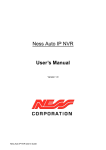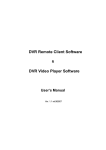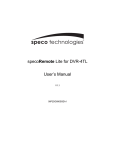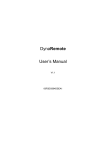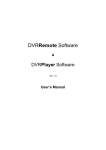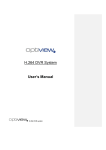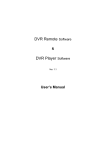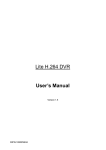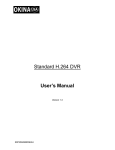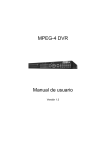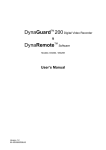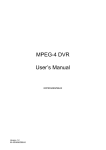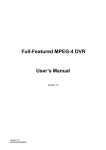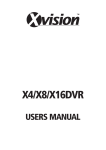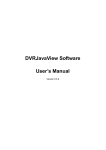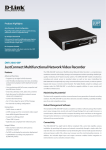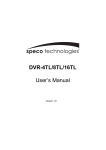Download DVR Server Operations Manual
Transcript
DVR-MR Series User’s Manual Ver 1.5 Version 1.5 rel.062007 Optiview USA User’s Manual 1 User’s Manual Caution and Preventive Tips • Switch the 115/230V selector to your local voltage standard • Handle with care, do not drop the unit • Mount the unit in an equipment rack or place it on a solid, stable surface. • Indoor use only. Do not place the unit in a humid, dusty, oily, or smoky site. • Do not place it in an area with poor ventilation or in an area close to fire or other sources of heat. Doing so may damage the unit as well as cause fire or an electric shock. • When cleaning is necessary, shut down the system and unplug the unit from the outlet before uncovering the top cover. Do not use liquid cleaners or aerosol cleaners. Use only a damp cloth for cleaning. • Always shut down the system prior connecting or disconnecting accessories, with the exception of USB devices. • Lithium battery: Danger of explosion if battery is incorrectly replaced. Replace with the same or equivalent type of batteries recommended by the manufacturer. Dispose used batteries according to the battery manufacturer’s instructions. This symbol intends to alert the user to the presence of important operating and maintenance (servicing) instructions in the literature accompanying the appliance. This symbol intends to alert the user to the presence of unprotected “Dangerous Voltage” within the product’s enclosure that may be strong enough to cause a risk of electric shock. 2 User’s Manual Important Information Before proceeding, please read and observe all instructions and warnings in this manual. Retain this manual with the original bill of sale for future reference and, if necessary, warranty service. When unpacking your unit, check for missing or damaged items. If any item is missing, or if damage is evident, DO NOT INSTALL OR OPERATE THIS PRODUCT. Contact your dealer for assistance. Rack Mounting Consult with the supplier or manufacturer of your equipment rack for the proper hardware and procedure of mounting this product in a safe fashion. Avoid uneven loading or mechanical instability when rack-mounting units. Make sure that units are installed to get enough airflow for safe operation. The maximum temperature for rack-mounted units is 40 °C. Check product label for power supply requirements to assure that no overloading of supply circuits or over current protection occurs. Mains grounding must be reliable and uncompromised by any connections. 3 Table of Content 1. Overview .......................................................................................................................3 1.1 Product Key Features ..........................................................................................3 1.2 Product Application Diagram................................................................................5 2. System Installation.......................................................................................................5 2.1 Position the Unit...................................................................................................5 2.2 Selecting Video Format........................................................................................6 2.3 Connecting Devices to the Unit............................................................................6 2.4 Rear Panel Connections ......................................................................................7 3. Setup Your Unit.............................................................................................................9 3.1 Front Panel Introduction ......................................................................................9 3.2 3.3 3.4 3.5 3.1.1 LED Indication ......................................................................................10 3.1.2 Functional Keys....................................................................................10 Power Up / Down the Unit .................................................................................13 Entering OSD Setup Menu ................................................................................14 3.3.1 Regular Key Usage in OSD Menu........................................................15 3.3.2 Key Usage in Virtual Keyboard.............................................................16 System Date / Time Setting ...............................................................................17 3.4.1 Set Date / Time.....................................................................................17 3.4.2 Daylight Saving Time............................................................................18 Record Schedule / Quality Setting .....................................................................19 3.5.1 Record Mode........................................................................................19 3.5.2 3.5.3 3.5.4 Schedule Setup ....................................................................................20 Preset Record Configuration ................................................................20 Per Camera Configuration....................................................................21 4. Basic Operation..........................................................................................................21 4.1 Viewing Live / Playback Video ...........................................................................21 4.1.1 Viewing Modes .....................................................................................22 4.1.2 Digital Zoom .........................................................................................22 4.1.3 4.1.4 4.2 4.3 Viewing Live Cameras..........................................................................22 Viewing in Sequence Mode.....................................................................23 To Freeze Live Image..............................................................................23 Viewing Recorded Video ......................................................................23 Key Usage in Playback ...........................................................................23 Pause Playback and Single Step Forward ..............................................24 Viewing Live Image in Playback Mode....................................................24 Call Monitor Control ...........................................................................................25 Searching Recorded Video ................................................................................26 Version 1.5 00P379200FSEA5 User’s Manual Search by Time..................................................................................................26 4.4 4.5 4.6 Search by Event ................................................................................................27 Deleting Recorded Video ...................................................................................28 Exporting Recorded Video .................................................................................28 4.5.1 Select Device .......................................................................................29 4.5.2 Select Video .........................................................................................29 4.5.3 Digital Signature ...................................................................................30 4.5.4 Erase Disc ............................................................................................31 Dome Control.....................................................................................................31 4.6.1 4.6.2 4.6.3 4.6.4 Dome Connection.................................................................................31 Dome Protocol Setup ...........................................................................32 RS485 Setup ........................................................................................33 Dome Controlling Key ..........................................................................33 4.6.5 4.6.6 Setting Preset Points ............................................................................35 Calling Preset Points ............................................................................36 Appendix A: Technical Specifications ...........................................................................37 Appendix B: Record Duration.........................................................................................39 2 User’s Manual 1. Overview The Versatile MPEG-4 DVR is an integrated digital video recorder that combines the features of a time-lapse audio / video recorder, a multiplexer, and a video server to create a single security CCTV solution. Its outstanding triplex+ operation enables user to view live, playback recorded video, and remote access through network simultaneously, while recording other video, and to view wanted recorded video instantly by entering the time and date or selecting recorded video from the event list. Versatile MPEG-4 DVR includes DVRRemote, the remote viewing and configuration software that is a Web-browser plug-in, allows user to view live or recorded video images and enables remote configuration. The remote software is stored in Versatile MPEG-4 DVR and deployed over a LAN, WAN or Internet connection to remote Windows-based computers. This simplifies the installation and maintenance of the software components so all remote users are kept up to date. 1.1 Product Key Features The Versatile MPEG-4 DVR offers advanced features not typically found in standard multiplexers; it integrates the full features of a DVR, multiplexer and video server (by using the software DVRRemote). The key features of Versatile MPEG-4 DVR are listed as follows. • • • MPEG-4 high quality compression Embedded Linux operating system Triplex+ operation enabling simultaneous viewing live or playback while continuing to record, simultaneously • Support VGA main output (optional) • • • Live display frame rate up to 240 pps (NTSC) / 200 pps (PAL) Recording frame rate up to 120 pps (NTSC) / 100pps (PAL) Powerful network functions: remote monitoring, control, playback via Ethernet and/or internet • Built with ezBurn technology, two keys (Search/ Call) are all you need for completing the video export • By selecting ezRecord function, user can select the period of days to record instead of complicated record settings 3 User’s Manual • Synchronized 2 channels audio live, recording, and playback (locally & remotely) • Built-in CD-RW or DVD+RW for video clip exporting (optional) • Easy software upgrade via Network, USB ThumbDrive®, CD/RW, or Internet Remote Application • Configurable normal and event recording frame rate & picture quality per channel • Exported AVI file can be played via Microsoft Media Player in any PC with DivX decoder installed • • DVRPlayer application software will be attached with exported disks DVRRemote web-based software for remote monitoring and control via LAN or Internet • 4 / Multiple built-in dome camera protocol (through RS-485): Pelco D, Pelco P, AD422 and Fastrax 2 / / / / / / / • • 2 internal hard drives support up to 1TB capacity external storage extension, 2 IEEE 1394 (FireWire®) ports for external CD/RW, DVD dual, portable HDD, or disk array • • Three USB 2.0 ports for video clip export and/or backup Powerful alarm processor allows flexible alarm trigger and responses, including alarm, motion, and camera failure • • • Pre-Alarm recording 30secs Multiple language on-screen menus Password to secure installation authorization • • • • • • • Network software supports static IP, DHCP, WLAN, PPPoE and DDNS Network hardware supports 10/100M Support RS-485 remote control keyboard (optional) 2X Digital Zoom available in both live and playback mode Export video (AVI) with audio and digital Signature Automatic camera detection (Plug & Play) Covert camera operation provides enhanced security and administrator control • Each camera can be configured respectively for camera settings, frame rate, picture bit rate, alarms, motion detection • • • Programmable day/ night/ weekend scheduling Programmable main monitor/ call-monitor switching sequence Universal power input, no external power unit User’s Manual 1.2 Product Application Diagram Connect the unit with other devices as shown in the system diagram to complete a video surveillance solution. The figure shows also the expandability and flexibility of this digital recording system. 2. System Installation The notices and introduction on system installation will be described particularly in this chapter. Please follow the description to operate the unit. In order to prevent the unit from data loss and system damage that caused by a sudden power fluctuation, use of an Uninterruptible Power Supply (UPS) is highly recommended 2.1 Position the Unit Firstly, note to position / mount the Versatile MPEG-4 DVR in a proper place and be sure to power off the unit before making connections. The placed location should avoid hindering or blocking the unit from airflow. Enough airflow is needed to protect the unit from overheating. The maximum 5 User’s Manual allowable temperature of operating environment is 40°C. The unit utilizes heat-conducting techniques to transfer internal heat to the case, especially to the bottom side of the unit. NOTE: Be sure not to remove the rubber feet, and always leave a space for air ventilation on the unit’s bottom side. 2.2 Selecting Video Format The Versatile MPEG-4 DVR is designed to operate under either NTSC or PAL video formats. Please contact with a qualified service person to perform the installation procedure. 2.3 Connecting Devices to the Unit This section lists some notices that should be given before making any connections to the Versatile MPEG-4 DVR. NOTE: Connect short-term devices, such as USB ThumbDrive, USB CD-RW, USB Hard Disk Drive, etc., only after the unit is successfully powered up. Connecting Required Devices Before power up the unit, you should connect cameras and a main monitor to the unit for basic operation. If needed, connect a call monitor for displaying full screen video of all installed cameras in sequence. Connecting Short-term Device If you plan to install any short-term devices to the Versatile MPEG-4 DVR and use them as part of the unit system, such as USB CD-RW, USB Hard Disk Drive, etc. Make sure connecting those devices only during the unit is powered up. Because Versatile MPEG-4 DVR can recognize the external devices only after the power-up process are completely. 6 User’s Manual 2.4 Rear Panel Connections There are various connectors on the rear panel used for Versatile MPEG-4 DVR installations. The following figure shows the connectors by name; and followed by the detailed description of each connector. 4-channel and 8-channel Versatile MPEG-4 DVR has 4 camera and 8 camera inputs and camera looping out connectors on the rear panel, respectively. Main Monitor (S-Video / BNC/ VGA) S-Video, BNC and VGA output connectors are offered for connecting to a main monitor. The main monitor displays live image and playback recorded video in full-screen or split-window format. Call Monitor (BNC) The call monitor is used to display full screen video of all installed cameras in sequence. The BNC call monitor connectors allow users to connect the Versatile MPEG-4 DVR with an optional call monitor. Video Input 4 or 8 BNC connectors are offered for video input streams from installed cameras. The number of connectors is equal to the number of channels. Camera Looping Plenty of BNC connectors are positioned on the real panel for looping out the video input. The number of these connectors is equal to the number of channels; 4-channel / 8-channel Versatile MPEG-4 DVR has 4 / 8 camera-looping connectors, respectively. 7 User’s Manual LAN Connector (RJ-45) The Versatile MPEG-4 DVR is capable of networking. The LAN port opens the door of Versatile MPEG-4 DVR to Ethernet by the Internet. Power Jack The Versatile MPEG-4 DVR has a free voltage AC power connection jack. Please connect the power supply that ships with the unit. WARNING: Use of other power supply may cause overloading. Power Switch Used to power up and shut down the unit. Audio In / Out The Versatile MPEG-4 DVR provides two channels of audio recording and playback. Audio In RCA connector is offered for connecting an audio source device (e.g. external amplified microphone) to the unit; Audio Out RCA connector is offered for connecting an audio output device (e.g. amplified speakers) to the unit. Alarm I/O & RS485 The unit provides an alarm I/O and RS485 port that offers user the flexibility required to connect the unit to the other device. Pin Pin Definition 1 RS485 D+ 11 Alarm In 1 2 RS485 D- 12 Alarm In 2 3 Ground 13 Alarm In 3 4 Normal Close A 14 Alarm In 4 5 Common Node A 15 Alarm In 5 (8ch Only) 6 Normal Open A 16 Alarm In 6(8ch Only) 7 Ground 17 Alarm In 7(8ch Only) 8 Normal Close B 18 Alarm In 8(8ch Only) 9 Common Node B 19 N/A Normal Open B 20 N/A 10 8 Definition User’s Manual RS-232C The unit provides a RS-232C communication port for sending and receiving signals. USB Connector (x2) There are two USB2.0 ports on the rear panel for users to connect external USB devices to the unit, such as ThumbDrive or CD-RW. IEEE 1394 FireWire® (x2) The Versatile MPEG-4 DVR is equipped with two IEEE 1394 (FireWire®) ports for extended connections. PAL / NTSC Switch This switch is used to adjust the unit to an appropriate video format. The adjusting is for qualified service personnel only. 3. Setup Your Unit The Versatile MPEG-4 DVR allows user to access some general operations through the front panel easily. The following sections introduce the general operations of the unit. The generally displayed OSD information and its position are shown in the following figure. Camera Title Operating Mode 3.1 Date / Time Front Panel Introduction The unit’s front panel controls enable user to control the unit and preset the programmable functions. The 8-channel Versatile MPEG-4 DVR front panel has 8 keys for 8 channels, respectively. The LED and function keys will be introduced by name and function in following sections. 9 User’s Manual 3.1.1 LED Indication The Versatile MPEG-4 DVR LEDs on the front panel are described as follows. Network LED (Green) The LED should be lit when Versatile MPEG-4 DVR is connected to a network and blink when the data is being transferred. Power LED (Green) The LED lit when the correct power is connected. HDD LED (Yellow) The LED should be lit while the HDD is processing data. REC LED (Green) The LED should blink while the Versatile MPEG-4 DVR is recording. Alarm LED (Red) The LED should be lit during an alarm is triggered. 3.1.2 Functional Keys The Versatile MPEG-4 DVR functional keys on the front panel for normal operation are described as follows. 10 User’s Manual CHANNEL • While the unit is under both Live and Playback mode, press the CHANNEL key to view the corresponding video in full screen. The number of the CHANNEL keys corresponds to the number of cameras supported by the unit. • While the unit is under dome control mode, the first key is used to access the Set/Go preset menu; the second key is used to hide or display the dome setting parameters. DOME Press this key to enter dome control mode. MODE Press repeatedly to select for wanted main monitor display format. There are three available view modes: full screen, 4-window (2×2) and 9-window (3×3). SEQ (Sequence) Press to start automatic sequencing of the video coming from the installed cameras. MENU Press the key to call the OSD setup menu. CALL Press to enter call monitor control mode. PLAY/STOP Press this key to switch between live image and playback video. FREEZE • The live video will be frozen if press FREEZE while viewing live image, but the date / time information shown on the monitor will continue updating. Press FREEZE again to return to live mode. • The playback video will be paused If press FREEZE when playing the recorded video. Press LEFT / RIGHT to resume playback video single step reverse / forward, respectively. Press FREEZE again to continue playing video. 11 User’s Manual SEARCH In both Playback and Live mode, user can press SEARCH to call the Search Menu for searching and playing back recorded video by date and time or events. ESC Press to cancel or exit from certain mode or OSD Menu without changing the settings. Direction Keys • In Zoom mode, these keys function as Direction keys. • In the OSD Menu, the Direction keys are used to move the cursor to previous or next fields. To change the value in the selected field, press UP / DOWN keys. ZOOM/ENTER • In OSD Menu or selection interface, press the key to make the selection or save settings. • In both live and playback full screen view mode, press to view a 2× zoom image; press it again to return. • In playback mode, the recorded video can be zoomed and moved to view more area. JOG/SHUTTLE • The jog/shuttle knob, shown as below figure, is a combination of a shuttle ring with an embedded jog disk, which is used to provide wide latitude in playback control. Note that the jog/shuttle knob is active only when the DVR unit has been in Playback mode. 12 User’s Manual • While playing back video, you can use the shuttle ring to select different speed of forward and backward playing. Rotating the shuttle ring counterclockwise causes the unit to playback into faster forward/ backward playing speed. According to the angle you rotate the shuttle ring, you can choose the playing speed from 1×, 2×, 4×, 8×, 16×, and 32×, in both forward and reverse directions, shown as below figure: • Inside the shuttle ring is the jog disk, shown as the figure, it can turns completely in either directions. Once you freeze the video, you can use the jog disk to go single-step playing back. Clockwise rotation causes a forward one-step playback; and counterclockwise rotation causes a backward one-step playback. 3.2 Power Up / Down the Unit If you must shut down the Versatile MPEG-4 DVR for any reason, please use the proper shut down and power up procedures to avoid damage to your unit. To Power Up the Unit Check the used type of power source before plug in the unit first, and turn on the unit using the power switch on the rear panel. The color bar and system checking information are shown on the monitor until the unit is completely started. 13 User’s Manual To Restart / Shutdown the Unit Press MENU and input the administrator password to access the OSD Main Menu. Select <Shutdown> in Main Menu and press ENTER to enter the Shutdown Menu, which displays as follows. Shutdown 1. Power Off 2. Reboot Execute Execute <Power Off> Select this item to shut down the unit. Do not remove the power during shut down until the message “You can safely turn off DVR now!” displays. <Reboot> Select this item to reboot the unit. The color bar and system checking information are displayed on the monitor until the unit is completely restarted. 3.3 Entering OSD Setup Menu The OSD Main Menu contains a list of items that are used to configure the Versatile MPEG-4 DVR. To enter the Main Menu, press MENU and then enter Administrator or User password. The Password Verification screen displays as follows. Password Verification ________ Press Channel Keys To Enter Password (4-8 Digits) Press ◄ Key To Delete The default passwords are shown in the following table. The same passwords are used for entering the remote viewing software DVRRemote. Administrator Password User Password 1234 4321 It is strongly suggested to change the passwords to prevent unauthorized access to the unit. 14 User’s Manual After entering the correct password, the Main Menu is displayed. Main Menu 1. System Setup 2. Monitor Setup 3. Camera Setup 4. Record Setup 5. Sequence Setup 6. Event Setup 7. Database Setup 8. Configuration 9. Video Export 10. Shutdown Move the cursor up / down over the OSD items using the Direction keys and press ENTER to enter the sub-menu of the selected item. 3.3.1 Regular Key Usage in OSD Menu Direction Keys In the OSD Menu, Direction keys are used to move the cursor to previous or next fields. UP / DOWN are used to change the value in the selected field. ENTER In OSD Menu or selection interface, press the key to make selection or save settings. ESC Press to cancel or exit from certain OSD Menu without saving any changes. 15 User’s Manual 3.3.2 Key Usage in Virtual Keyboard A virtual keyboard shows when edit certain settings in the OSD Main Menu, such as camera title, e-mail address, etc. The virtual keyboard displays as follows. A B C D E F G H I K L M N O P Q R S T U V W X Y Z a b c d e f g h i j k l m n o p q r s t u v w x y z 0 1 2 3 4 5 6 7 8 9 . ! @ # − _ ◄ ► Cancel Backspace J Delete OK To move the cursor on the virtual keyboard Use Direction keys to move and position the cursor over the character you want. To input characters into the title entry After positioning the cursor on the wanted character, press ENTER to input this character into the title entry. To move the cursor within title entry Press MODE and LEFT / RIGHT key simultaneously to move the cursor left / right within the title entry. To delete previous character within the title entry To delete the character positioned in front of the cursor within the title entry, use Direction keys to move the cursor to <Backspace> and press ENTER. To delete current character within the title entry To delete the character hovered over by the cursor, use Direction keys to move the cursor to <Delete> and press ENTER. To exit the virtual keyboard Move the cursor to <OK> and press ENTER to save the settings and exit; or press ESC to exit without saving changes 16 User’s Manual 3.4 System Date / Time Setting User can set the current date, time and other OSD parameters in Date/Time Menu. In OSD Main Menu, select <System Setup> and press ENTER, then select <Date/Time> to access the Date/Time Menu; the menu displays as follows. Date/Time 1. Date 2. Time 3. Date/Time Display 4. Date Display Mode 5. Time Display Mode 6. Date/Time Order 7. Daylight Saving Time 8. DST Start 9. DST End 10. DST Bias 3.4.1 2005/02/21 10:39:26 1 Row Y/M/D 24 HR Date First ON Apr, 1 st Sun, 02:00 Apr, Last Sun, 02:00 60 Min Set Date / Time Set Date / Time Select <Date/ Time> and press ENTER for adjusting the settings. LEFT / RIGHT keys are used here to move the cursor to previous or next field, press ENTER for selecting, and UP / DOWN for changing the value of the selected field. NOTE: The reset date / time setting applies to video recorded after the date/ time adjusting; the date and time of previously recorded video will not be changed. NOTE: Once the date / time setting has been changed, We strongly recommend to purge the video stored in the database immediately to avoid record database corruption. Date / Time Display Users are allowed to choose to set the date / time OSD displays in 1 or 2 rows. The default is to display the date / time OSD in one row. 17 User’s Manual Date Display Mode This function allows user to set the OSD display type of the date / time. There are three options to select from: <Y/M/D>, <M/D/Y> or <D/M/Y>. “Y” represents “Year”, “M” represents “Month” and “D” represents “Day”. The default setting is <Y/M/D> in both NTSC / PAL formats. Time Display Mode User can choose to set the time format to <12 hour> or <24 hour>. The default setting is <24 hour>. Date / Time Order The item is used to set the order of date / time display to <Date First> or <Time First>. 3.4.2 Daylight Saving Time Daylight Saving Time The item is for those people who live in certain regions to observe Daylight Saving Time. Select <ON> to enable, or <OFF> to disable the function. If the function is disabled, the following items <DST Start>,<DST End> and <DST Bias> will be grayed out and cannot be accessed. NOTE: If this function is enabled, the date/time information will be shown on the screen with a DST icon when playing back recorded video or searching video in the event list. “S” indicates summer time and “W” indicates wintertime. DST Start / DST End These two items are used to program the activate duration of daylight saving time. DST Bias The item allows users to set the amount of time to move forward from the standard time for daylight saving time. The available options are <30>, <60>, <90> and <120> minutes. 18 User’s Manual 3.5 Record Schedule / Quality Setting The Record Setup Menu allows user to set recording quality, recording schedules, and other recording parameters. Administrator's password is required to enter <Record Setup> Menu. In the Main Menu, select <Record Setup> and press ENTER; the following menu displays. Record Setup 1. Record Mode 2. Schedule Setup 3. Preset Config 4. Per Camera Config 5. ezRecord Setup 6. Data Lifetime 7. Pre-Alarm Recording 8. Circular Recording 9. Audio Recording 10. Purge Data 3.5.1 720× ×240@60PPS Standard 7 Days 15 Sec ON ON Record Mode The <Record Mode> is used to select recorded resolution and frame rate. The option you select here will override other relative record settings, such as preset configuration. The options are <720 × 480@30PPS>, <720 × 240@60PPS> and <360 × 240@120PPS> in NTSC video format, and <720 × 576@25PPS>, <720 × 288@50PPS>, <360× ×288@100PPS> in PAL video format. Move the cursor to <Record Mode> and press ENTER, then select a Record mode using UP / DOWN keys. NOTE: If the recorded option <720 × 480@30PPS> (or 720 × 576@25PPS) has been selected, only the image from channel 1~4 will be recorded. NOTE: After changing the Record Mode setting, the warning message “This will FORMAT ALL HARDDISKS and LOAD THE FACTORY DEFAULT CONFIG!” will show up. Press ENTER to confirm the selection, then the unit starts to format the installed hard disks and load the factory default settings, or press ESC to abort. 19 User’s Manual 3.5.2 Schedule Setup The Schedule Setup is used to set the day and night time, or weekend recording schedule. Select <Schedule Setup> from the Record Setup Menu and press ENTER; the following menu is displayed. Schedule Setup 1. Day Time Start 2. Day Time End 3. Night Time Start 4. Night Time End 5. Weekend Schedule 6. Weekend Start 7. Weekend End AM PM PM AM 06:00 18:00 18:00 06:00 YES Fri 18:00 Mon 06:00 • Make appropriate changes of the start time of Day and Night Time using Direction keys. • Press ENTER to confirm the settings or ESC to cancel. • If you want to have a weekend record, choose <YES> to enable the <Weekend Schedule> in advance and then set <Weekend Start> / <Weekend End>. • Press ESC to back to previous page. 3.5.3 Preset Record Configuration The <Preset Config> is used to select the preset recording quality and frame rate. In normal circumstances, we strongly suggest you set the item to <Standard>, the default. Below table shows the PPS and picture size under <Standard> in Half-D1 mode. Half-D1 mode (NTSC: 720x240@60PPS; PAL: 720x288@50PPS) Normal PPS Normal Size Event PPS Event Size 7.5 NTSC 30 NTSC 18 KB 30 KB (6.25 PAL) (25 PAL) 20 User’s Manual 3.5.4 Per Camera Configuration This function is used to set the Day / Night / Weekend PPS (Picture per Second) and Quality for each channel. The Preset Configuration must be set to <OFF> for accessing these schedules. The menu is displayed as below (Record Mode: 720×240@60PPS in NTSC / 720×288@50PPS in PAL). Per Camera Config Cameral Select Normal PPS Normal Qlty Event Max PPS Event Qlty Event Acti Day 7.5 Mid 30 Best Both Night 7.5 Mid 30 Best Both CH1 Weekend 7.5 Mid 30 Best Both • Firstly, select a wanted Camera for setting its record configuration. The image and recording settings of the selected camera will be displayed on the screen. • Move the cursor using Direction keys and press ENTER to select an item. • Change the value using UP / DOWN keys. • Press ENTER to confirm the settings or ESC to abort. • Press ESC to return to <Record Setup> Menu. Please note that the total normal pps for all channels cannot exceed 120 NTSC (360×240@60PPS) / 100 PAL (360×288@50PPS) . To increase one channel’s pps, you may have to reduce the others’ first. Event pps is not restricted to this rule, since a smart event scheduler will handle to the total pps with a correct weighting. 4. Basic Operation The Versatile MPEG-4 DVR allows user to access some general operations through the front panel easily. The following sections introduce the general operations of the unit. 4.1 Viewing Live / Playback Video The general functions can be accessed in both live and playback modes are described in the following sections. 21 User’s Manual 4.1.1 Viewing Modes The Versatile MPEG-4 DVR supplies users versatile ways of viewing both live and recorded video. Following presents these view formats. Viewing in Full Screen Press wanted CHANNEL key directly to view the corresponding camera image in full view format. Viewing in Multi-window Various multi-window view formats are offered for selecting. To switch between available viewing formats, press MODE repeatedly. The available view formats are illustrated as the following figure. The 3 x 3 mode is for 8-channel unit only. 4.1.2 Digital Zoom Users can view a 2× full screen in live and playback mode. To view the 2× full screen, follow the steps. • Press a CHANNEL key to view the corresponding camera in full screen. • Press ZOOM to enter a 2× full screen zoom mode of the selected camera. • If you need to view specific area of the 2× zoomed screen, use Direction keys to pan / tilt the zoomed area around the original image. • Either press ZOOM again or ESC to leave the zoom mode. 4.1.3 Viewing Live Cameras Users are allowed to view live camera in versatile view modes, such as full-screen, 2×2 and 3×3. The general operation under live mode is described as follows. 22 User’s Manual Viewing in Sequence Mode Automatic sequence function can be used in any view mode. Select certain view format and press SEQ to toggle the automatic sequential sequence, press ESC to stop sequencing. The figure below displays the 4-camera sequencing view modes. To Freeze Live Image Press FREEZE while viewing live image, the image pauses but the date / time information does not, and the system clock continues running. Press FREEZE to pause the live image; press FREEZE again to resume the live camera view. 4.1.4 Viewing Recorded Video To view recorded video, user can press PLAY/STOP key directly. When press the PLAY/STOP key, the unit starts to continue playing back the recorded video from the suspended point of record. If it is the first time to use the PLAY/STOP key, the unit will playback from the very beginning of the record. Alternatively, user can select records from the Search Menu to play specific video. Refer to section 4.3 Searching Recorded Video for more information. The Forward or Reverse speed indicator will be shown on the bottom-left of the screen, when in the playback mode. The general operation in playback mode is described as follows. Key Usage in Playback The key usage is slightly changed in playback mode. Following is the key usage found in playback mode. 23 User’s Manual LEFT (Reverse Playback) The key is used to reverse the recorded video while the unit is playing back. Press the key repeatedly to increase the speed of reverse playback by 1×, 2×, 4×, 8×, 16×, or 32×. RIGHT (Forward Playback) The key is used to play the recorded video fast forward. Press the key repeatedly to increase the speed of forward playback by 1×, 2×, 4×, 8×, 16×, or 32×. FREEZE Press FREEZE to pause the playback video. When the recorded video is paused, press LEFT / RIGHT to resume playback video single step reverse / forward, respectively. Press FREEZE again to continue playing video. ESC Press to exit current mode or stop playing back video and back to live mode. Pause Playback and Single Step Forward To pause and resume recorded video, follow these steps. • Press the wanted CHANNEL keys to display the corresponding camera in full screen. • Press FREEZE to pause the current playback image. • Press RIGHT / LEFT Direction keys to move the video single step forward / reverse. Press and hold RIGHT / LEFT keys to forward / reverse the video single step continuously. • Press FREEZE again to resume the playback operation. Viewing Live Image in Playback Mode Press the MODE key repeatedly in playback mode, a 9-window viewing mode contains both live and playback image appears. This view mode is illustrated as the following figure. 24 User’s Manual The four windows on the top-left play back the recorded video of channel 1 to channel 4, respectively, and the rest windows display the live image of channel 1 to channel 4. 4.2 Call Monitor Control Users are allowed to use the Versatile MPEG-4 DVR unit front panel to control a call monitor display without having to access the Main Menu. Two viewing modes, including Sequence display and Single camera display, can be performed through the call monitor. To program the call monitor sequence, see section 5.5 Sequence Setup. Follow the steps to control your call monitor. • Press the CALL key on the front panel to enter call monitor control mode, the message “Call Mode” will be shown on the bottom-left corner of the screen. Press 1-8 Key To Select Channel Press SEQ To Enable Sequence Call Mode • Press CHANNEL key to display the associated camera on call monitor. • Alternatively, press SEQ repeatedly to display the sequence of cameras previously programmed in <Call Monitor Schedule> Menu. • Press ESC to return to Main monitor control mode. 25 User’s Manual 4.3 Searching Recorded Video The Versatile MPEG-4 DVR is capable of searching and playing back recorded video by date and time or events. Entering the specific date and time, the unit will then search for the matched video and play it on the monitor. Alternatively, users can search event video by selecting channel as well. No matter in live or playback mode, press SEARCH to enter the Search Menu, which is shown as follows. Search ----------Search By Time---------From: 2005/01/01 AM00:00:00 End: 2005/05/01 PM00:00:00 Start: 2005/01/01 AM00:00:00 Begin Playback ----------Search By Event---------Select Channel: CH1 CH2 CH3 CH4 Event List Search by Time Follow the steps to search video by date and time. • Press SEARCH key to enter the Search Menu; the <From Time> and <End Time> of the available video is listed on top of the screen. The information displayed is for read only. • Use Direction keys to move the cursor for setting the Start Time; adjusting the date and time values by UP / DOWN keys. • Press ENTER to confirm the settings or ESC to abort. • Move the cursor to <Begin Playback> and press ENTER to start playing back the selected video. • Either press PLAY/STOP again or ESC to return to live video. NOTE: If there is no available recorded video that matches your specified time and date, the unit starts playback from the next available video. NOTE: The date/time information will be shown on the screen with a DST icon if the Daylight Saving Time function is enabled. “S” indicates summer time and “W” indicates wintertime. 26 User’s Manual Search by Event Follow the steps to search video by event. • Press SEARCH key to enter the <Search> Menu. • To search event video that was recorded on a specific camera, use LEFT / RIGHT to move the cursor and press ENTER to select or de-select a channel. • Move the cursor to <Event List> and press ENTER to list the event video of the selected channels. The Event List displays as follows. No. 1 2 3 4 5 6 7 8 9 10 11 Event List Date Time 2005/03/17 11:26:50 2005/03/17 09:53:03 2005/03/16 16:14:42 2005/03/15 03:45:31 2005/03/12 22:27:56 2005/03/12 10:09:29 2005/03/11 12:18:20 2005/03/10 05:16:00 2005/03/08 17:11:37 2005/03/08 16:29:10 2005/03/08 03:22:17 Ch. 2 5 3 1 1 7 6 4 2 8 2 Type Motion Alarm Alarm Motion Alarm Motion Motion Alarm Motion Motion Alarm The list displays each event by its date, time, triggered camera and alarm type. The latest recorded event video will be positioned on the top of the list. To exit the event list, press ESC. Follow these steps to playback video from event list. • Use UP / DOWN to scroll through the Event List. • Press ENTER to play back the selected event record. • Press PLAY/STOP or ESC to return to live mode. 27 User’s Manual 4.4 Deleting Recorded Video Users can delete the Normal and Event recorded video in <Purge Data> Menu. The administrator password is required to access the function. Select <Record Setup> from Main Menu, and then select <Purge Data> and press ENTER, the <Purge Data> Menu displays. Purge Data 1. Purge All Data 2. Purge All Event Data 3. Purge Event Before 4. Start to Purge NO NO 2005/01/01 NO The first three items are used to select the data that should be purged. The items are described as follows. After select the data you want to purge, set the fourth item <Start to Purge> to <YES> and press ENTER to start the deleting process. Purge All Data Select the item to delete all recorded video from database. Purge All Event Data Select the item to delete all event video from database. Purge Event Before To delete event video that is recorded before a specific date. 4.5 Exporting Recorded Video The <Video Export> Menu, under the Main Menu, enables the administrator to export recorded video with digital signature to a USB ThumbDrive, a CD-RW or to DVD+RW drive. Administrator's password is required to export video. The exported video will be named by the exporting date and time, and classified by event type. Each recorded video will be exported into four files if exported with digital signature, including *.gpg, *.avi (or *.drv; depends on the file format you had chosen), *.sig and readme txt. Make sure an external storage device is available and has been connected to the appropriate port for video exporting. 28 User’s Manual From the Main Menu, select <Video Export> and press ENTER. The following menu is displayed. Video Export 1. Select Device 2. Select Ch: 3. From 4. To 5. Select Events 6. Data Type 7. Export Format 8. Digital Signature 9. Erase Disc 10. Begin Export 4.5.1 CH1 CH2 CH3 CH4 2005/03/19 AM 07:50:05 2005/03/28 PM 03:09:18 Normal DRV No No No Select Device The available external devices for exporting video will be listed by name and free size in Select Device Menu. The Select Device Menu displays as follows. Select Device Device Name xxx-xxx-x-x-xx xx-xxx-xx-xxxx Available 256 MB 1.5 GB Sel No No The Versatile MPEG-4 DVR only supports EXT3 file system. Before connecting an external HDD to the unit, ensure the format of HDD is EXT3. The connected devices will be listed by model name, and available space. Select <YES> for the device you want to export the video to, and select <NO> for the rest devices. Note that only one device should be chosen as the exporting destination. 4.5.2 Select Video After selecting video clips, set the item <Begin Export> to <YES> and press ENTER to start exporting. Following are the items for selecting video. Select Channel Select the channel that the administrator wants to export. Move the cursor to the wanted channel using LEFT / RIGHT keys, select or de-select a channel by pressing ENTER. 29 User’s Manual From / To Time The items are used to set the time which data export begins and ends. Move the cursor using Direction keys, and press ENTER to select the date / time items; adjust the selected date and time value by UP / DOWN keys. NOTE: The exported data between the Start Time and End Time includes both normal and event video. Select Events Select the item to display the event list for exporting event video. Move the cursor scroll the event list and press ENTER to select the event you want to export. Data Type The item is used to select exporting video type. The options are <Normal> (export normal video only), <Event> (export event video only) and <Both> (export both normal and event video). Export Format The item is for selecting exporting video format. The options are <DRV> and <AVI>. The *.drv file can only be played back with the attached software, DVRPlayer, and multiple camera video can be played from one file. The *.avi file can be played back with Microsoft Media Player. Note that if multiple channels are exported, each channel is exported to a separate file. 4.5.3 Digital Signature User can export video clip with or without a digital signature. Set the item to <YES> to export with the signature file, or <NO> to export without the signature file. Each recorded video with digital signature will be exported into four files, including *.gpg, *.avi, *.sig and readme txt. The *.gpg file name is as the last eight MAC (Media Access Control) address of the unit. 30 User’s Manual Make sure that you have an external storage device, such as a USB Hard Drive or USB ThumbDrive, available and connected to the appropriate port for export. For more information on verifying digital signature, see Appendix D: Verifying Digital Signature. 4.5.4 Erase Disc This function is used to remove information found on a CD-RW or DVD+RW disk prior to exporting new information to the drive. Select <YES> and press ENTER to start deleting data. 4.6 Dome Control Versatile MPEG-4 DVR allows user to control a dome camera by the front panel. In Live mode, press CHANNEL key to display the desired dome camera in full view. To enter Dome Control mode, press the DOME key and press channel key 2 to display the hint screen; to exit the Dome Control mode and back to live mode, press ESC or DOME. To configure the dome controls settings, see the following sections. 4.6.1 Dome Connection Follow the steps to install dome camera. • See section 2.4 Rear Panel Connections for RS-485 port pin definition. • Refer to the following figure. Connect the R+, R- terminals on the dome camera to the D+, D- terminals on the RS-485 port by RS-485 cable respectively. 31 User’s Manual 4.6.2 Dome Protocol Setup The <Dome Protocol> item lists the available dome protocols for communicating with dome cameras connected to the Versatile MPEG-4 DVR. From the Main Menu, select <Camera Setup> and press ENTER. The following menu is displayed. Camera Setup 1. Camera Select 2. Dome Protocol 3. Dome ID 4. Camera Title 5. Covert 6. Termination 7. Brightness 8. Contrast 9. Saturation 10. Hue 11. Audio Association CH1 None 0 NO NO 0 0 0 0 Both To configure dome protocol, select a camera first and set the communications protocol associated with dome camera using the Direction keys and ENTER. The available protocol includes <Pelco D>, <Pelco P>, / / / / / / / <AD422>, <Fastrax 2> and <None> (default). NOTE: The settings become effective after saving the changes and exiting from the menu. 32 User’s Manual 4.6.3 RS485 Setup Versatile MPEG-4 DVR control the domes via RS-485 communication protocol. The RS-485 parameters in Versatile MPEG-4 DVR must be set to the same parameters as the protocol for RS-422 setup of the dome. Users are allowed to change the RS-485 settings of the Versatile MPEG-4 DVR. Select <System Setup> in Main Menu, then select <RS485 Setup> from the System Setup Menu and press ENTER. The following menu is displayed. RS485 Setup 1 Unit ID 2 Baud Rate 3 Bits 4 Stop 5 Parity 224 9600 8 1 None The ID number must match the ID address set by the dome. The Unit ID is in the range of 1 to 255. The default ID is 224. Note that no two devices on the same bus should be given the same ID address, or a conflict may occur. The default RS-485 settings of Versatile MPEG-4 DVR are 9600 Baud, 8 Data Bits, 1 Stop Bit and No Parity. NOTE: The settings become effective after saving the changes and exiting from the menu. 4.6.4 Dome Controlling Key The function keys used in Dome Control are described as follows. 33 User’s Manual Set / Go Preset This key is used to enter the Dome Preset Menu to set up certain position as a preset and go to the predetermined preset positions for viewing. Toggle Hint Screen This function is used to avoid viewing the dome parameter information while controlling dome camera. Press this key to hide the screen. Press it again to redisplay the screen. Iris Open Use to open the Iris on the dome camera. Focus Far Use to focus the selected dome camera far. Zoom Out Use to zoom the dome camera out. This function is for user to choose the viewing area, more or less of it. ESC Use to leave dome control mode and return to live and full screen viewing mode. Enter / Auto • In OSD Menu mode, the key is used to make selection. • In dome control mode, this key is used to activate automatic focus and iris function. Iris Close Use to close the Iris on the dome camera. Focus Near Use to focus the dome camera near. Zoom In Use to zoom the dome camera in. This function is for user to choose the viewing area, more or less of it. Pan / Tilt Use to pan and tilt dome camera. 34 User’s Manual 4.6.5 Setting Preset Points The Versatile MPEG-4 DVR allows user to set preset positions; the amount of preset points depends on the dome manufacturer. Follow the steps to set preset points. • Press a Channel key to view the corresponding camera in full screen. • Then press DOME to enter dome control mode. • Use Direction keys to position the dome camera to desired position. • Press 2 to view the dome control Hint Screen; press 2 again to toggle the Hint Screen. Hint Screen DOME / ESC: Exit MODE / PLAY: Iris Open / Close SEQ / FREEZE: Focus Near / Far MENU / SEARCH: Zoom In / Out ENTER: Auto Focus / Iris ◄▲▼►: Pan / Tilt CH1: Set / Go Preset CH2: Hint Screen On / Off Dome Control • Press 1 to access the Set/Go Preset function. The Dome Preset Menu is displayed. Index 1 2 3 4 5 6 7 Dome Preset Set Preset NO NO NO NO NO NO NO Go Preset NO NO NO NO NO NO NO • Use UP / DOWN keys to select the desired preset number from the menu. • Set the <Set Preset> of the selected preset number to <YES>, and press ENTER to save the position. Now the preset is set and ready to call. 35 User’s Manual 4.6.6 Calling Preset Points Follow the steps to call preset points. • Press a Channel key to view the corresponding camera in full screen. • Then press DOME to enter dome control mode. • Press 2 to view the dome control Hint Screen; press 2 again to toggle the Hint Screen. • Press 1 to access the Set/Go Preset function. Index 1 2 3 4 5 6 7 Dome Preset Set Preset NO NO NO NO NO NO NO Go Preset NO NO NO NO NO NO NO • Use UP / DOWN keys to select the desired preset number from the menu. • Set the <Go Preset> of the selected preset number to <YES>, and press ENTER to call the preset point. • Now the selected dome camera rotates to the preset position automatically. 36 User’s Manual Appendix A: Technical Specifications All specifications are subject to change without notice. Specifications Unit size Video Operation Operating system 4ch Versatile DVR Half rack mountable/ 1 U Triplex+ operation Embedded MPEG-4 Compression algorithm Video Inputs 8ch Versatile DVR 4 Channels, 8 Channels, Vp-p/75 ohm Vp-p/75 ohm Main Monitor Output 1 BNC, 1 VGA, S-video, Vp-p/75 ohm Call Monitor Output 1 BNC Yes VGA Output Alarm Input Alarm Output Video Loss Detection 4 alarm inputs 8 alarm inputs 2 relay outputs Automatic Covert camera Yes Display options 1, 2×2, 3×3 View live or playback while recording Live update speed Live image resolution Yes 4CH: 120 pps (NTSC) / 100 pps (PAL) 8CH: 240 pps (NTSC) / 200 pps (PAL) 720×480 (NTSC) / 720×576 (PAL) (selectable) 720×480@30pps (NTSC) 720×576@25pps (PAL) Record resolution & Record speed 720×240@60pps (NTSC) 720×288@50pps (PAL) 360×240@120pps (NTSC) 360×288@100pps (PAL) Audio capability Image size Pre-alarm recording Motion detection Record modes Internal Storage External off-line storage 2 channels record & playback, 8 KHz/16 bits, ADPCM Compression 1K ~ 13K Byte/picture 5 to 30 sec Yes Linear/ circular x2 ATA 133 HDD / UDMA133 / IDE HDD USB 2.0 port (x3) or IEEE-1394 (x2)(FireWire®) for ThumbDrive®, CD/RW, DVD dual 37 User’s Manual Dome Control Protocols Ethernet RS232C RS485 Authentication Remote Software Operating Temperature Unit Dimension (WxHxD) Unit Weight Shipping Dimension (WxHxD) Shipping Weight Power Consumption & Input 38 Pelco P, Pelco D, AD422, Fastrax2. 10/100M, RJ45, DHCP / PPPoE / DDNS full support D-Sub 9 pin female Terminal block Digital signature on export DVRRemote software included 0~40 °C 432×413×55 mm Approximate 4 kg (8.8 lbs) 350×180×420 mm Approximate 5 kg (11 lbs) AC 100~240V, 35W, 50~60Hz User’s Manual Appendix B: Record Duration The record duration relates to recording rate, image quality and HDD capacity. Refer to the following table. NOTE: Record duration times are based on actual tests and represent average file sizes. Performance may vary depending on specific installations and use. Audio recording requires 8 KB per second (or 0.7 GB per day) for data storage. 160 GB Internal Memory @ full D-1 resolution 720×480 Recording Rate Recording Picture Quality Mode Lowest Total PPS Total PPS NTSC PAL NTSC PAL 6 6 Low Normal High Highest NTSC PAL NTSC PAL NTSC PAL NTSC PAL 12 12 18 18 24 24 30 30 120 100 2.70 3.24 1.35 1.62 0.90 1.08 0.67 0.81 0.54 0.65 60 50 5.4 6.5 2.7 3.2 1.8 2.2 1.3 1.6 1.1 1.3 30 25 10.8 12.9 5.4 6.5 3.6 4.3 2.7 3.2 2.2 2.6 15 12.5 21.6 25.9 10.8 12.9 7.2 8.6 5.4 6.5 4.3 5.2 11.3 9.38 28.6 34.5 14.3 17.3 9.5 11.5 7.2 8.6 5.7 6.9 7.5 6.25 43.2 51.8 21.6 25.9 14.4 17.3 10.8 12.9 8.6 10.4 3.75 3.12 86.30 103.73 43.15 51.86 28.77 34.58 21.58 25.93 17.26 20.75 1 1 323.63 160 161.82 107.88 80.91 64.73 GB Internal Memory @ half D-1 resolution 720×240 Recording Rate Lowest Total PPS Total PPS NTSC PAL NTSC PAL 4 4 Recording Picture Quality Mode Low Normal High NTSC PAL NTSC PAL NTSC PAL 8 8 12 12 16 16 Highest NTSC PAL 20 20 120 100 4.05 4.85 2.02 2.43 1.35 1.62 1.01 1.21 0.81 0.97 60 50 8.09 9.71 4.05 4.85 2.70 3.24 2.02 2.43 1.62 1.94 30 25 16.18 19.42 8.09 9.71 5.39 6.47 4.05 4.85 3.24 3.88 15 12.5 32.36 38.84 16.18 19.42 10.79 12.95 8.09 9.71 6.47 7.77 11.3 9.38 42.96 51.75 21.48 25.88 14.32 17.25 10.74 12.94 8.59 10.35 7.5 6.25 64.73 77.67 32.36 38.84 21.58 25.89 16.18 19.42 12.95 15.53 3.75 3.12 129.45 155.59 64.73 77.80 43.15 51.86 32.36 38.90 25.89 31.12 1 1 485.45 242.73 161.82 121.36 97.09 39 User’s Manual 160 GB Internal Memory @ CIF resolution 360×240 Recording Rate Lowest Total PPS Total PPS NTSC PAL PAL NTSC 2 2 40 Recording Picture Quality Mode Low Normal High NTSC PAL NTSC PAL NTSC PAL 5 5 8 8 11 11 Highest NTSC PAL 14 14 120 100 8.09 9.71 3.24 3.88 2.02 2.43 1.47 1.77 1.16 1.39 60 50 16.18 19.42 6.47 7.77 4.05 4.85 2.94 3.53 2.31 2.77 30 25 32.36 38.84 12.95 15.53 8.09 9.71 5.88 7.06 4.62 5.55 15 12.5 64.73 77.67 25.89 31.07 16.18 19.42 11.77 14.12 9.25 11.10 11.3 9.38 85.92 103.51 34.37 41.40 21.48 25.88 15.62 18.82 12.27 14.79 7.5 6.25 129.45 155.34 51.78 62.14 32.36 38.84 23.54 28.24 18.49 22.19 3.75 3.12 258.91 311.19 103.56 124.47 64.73 77.80 47.07 56.58 36.99 44.46 1 1 970.90 388.36 242.73 176.53 138.70













































